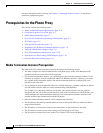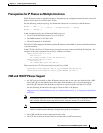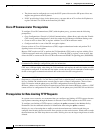
17-13
Cisco ASA Series Firewall ASDM Configuration Guide
Chapter 17 Configuring the Cisco Phone Proxy
Phone Proxy Guidelines and Limitations
format: SEP<mac_address>.cnf.xml. If the device name does not follow this format
(SEP<mac_address>), CIPC cannot retrieve its configuration file from Cisco UMC via the phone
proxy and CIPC will not function.
• The phone proxy does not support IP phones sending SCCP video messages using Cisco VT
Advantage because SCCP video messages do not support SRTP keys.
• For mixed-mode clusters, the phone proxy does not support the Cisco Unified Call Manager using
TFTP to send encrypted configuration files to IP phones through the ASA.
• Multiple IP phones behind one NAT device must be configured to use the same security mode.
When the phone proxy is configured for a mixed-mode cluster and multiple IP phones are behind
one NAT device and registering through the phone proxy, all the SIP and SCCP IP phones must be
configured as authenticated or encrypted, or all as non-secure on the Unified Call Manager.
For example, if there are four IP phones behind one NAT device where two IP phones are configured
using SIP and two IP phones are configured using SCCP, the following configurations on the Unified
Call Manager are acceptable:
–
Two SIP IP phones: one IP phone in authenticated mode and one in encrypted mode, both in
authenticated mode, or both in encrypted mode
Two SCCP IP phones: one IP phone in authenticated mode and one in encrypted mode, both in
authenticated mode, or both in encrypted mode
–
Two SIP IP phones: both in non-secure mode
Two SCCP IP phones: one IP phone in authenticated mode and one in encrypted mode, both in
authenticated mode, both in encrypted mode
–
Two SIP IP phones: one IP phone in authenticated mode and one in encrypted mode, both in
authenticated mode, both in encrypted mode
Two SCCP IP phones: both in non-secure mode
This limitation results from the way the application-redirect rules (rules that convert TLS to TCP)
are created for the IP phones.
Media Termination Address Guidelines and Limitations
The phone proxy has the following limitations relating to configuring the media-termination address:
• When configuring the media-termination address, the phone proxy does not support having internal
IP phones (IP phones on the inside network) being on a different network interface from the Cisco
UCM unless the IP phones are forced to use the non-secure Security mode.
When internal IP phones are on a different network interface than the Cisco UCM, the IP phones
signalling sessions still go through ASA; however, the IP phone traffic does not go through the
phone proxy. Therefore, Cisco recommends that you deploy internal IP phones on the same network
interface as the Cisco UMC.
If the Cisco UMC and the internal IP phones must be on different network interfaces, you must add
routes for the internal IP phones to access the network interface of the media-termination address
where Cisco UMC resides.
When the phone proxy is configured to use a global media-termination address, all IP phones see
the same global address, which is a public routable address.


















